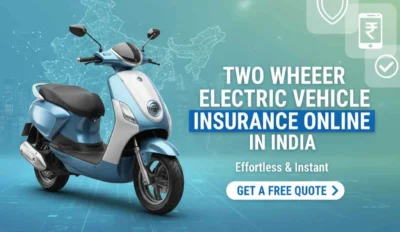So, you’ve finally bought your dream bike. That fresh smell, shiny paint, and the thought of endless rides make the wait worth it. But here’s the thing—owning a new bike isn’t just about cruising on the highway. It also comes with responsibility, and one of the first things you’ll need is two wheeler insurance for new bike.
In fact, in India, riding without insurance isn’t just risky—it’s illegal. The Motor Vehicles Act makes at least third-party insurance mandatory for every bike owner. But beyond the law, insurance protects you financially in case of accidents, theft, or damage. Still, many new bike owners feel lost when it comes to choosing the right policy. Let’s break it down in simple terms.
Why Insurance Matters for a New Bike
Buying a bike is often a dream-come-true moment. But imagine parking it outside your office one day, only to find it gone. Or picture a minor accident turning into a hefty repair bill. That’s where new bike insurance steps in—it cushions you against unexpected costs.
Here are some practical reasons why it’s a must:
- Legal Requirement: Without insurance, you risk heavy fines and penalties.
- Financial Safety: Repairs for new models can burn a hole in your pocket. Insurance reduces that burden.
- Peace of Mind: Knowing your investment is protected lets you enjoy rides stress-free.
- Resale Value Boost: A well-maintained bike with valid insurance often fetches a better price.
Types of Two Wheeler Insurance Policies
When you start looking for two wheeler insurance for new bike, you’ll usually find two main categories.
1. Third-Party Insurance
This is the most basic and mandatory cover. It only protects you against damages caused to another person, their bike, or property. For example, if you accidentally hit someone’s scooter, your insurer covers those costs. But note—it doesn’t cover your own bike’s damage.
Best for: Riders on a budget or those who use their bike less frequently.
2. Comprehensive Insurance
This is a more complete package. It covers third-party liabilities as well as damages to your own bike from accidents, theft, natural disasters, fire, or even vandalism. While premiums are higher, the protection is much broader.
Best for: New bike owners who want maximum protection.
Add-On Covers Worth Considering
Buying insurance for a new bike isn’t just about choosing between third-party or comprehensive. You can customize your plan with add-ons:
- Zero Depreciation Cover: Ensures you get full claim amount without depreciation cuts on bike parts.
- Roadside Assistance: Handy if your bike breaks down mid-journey.
- Engine Protection: Covers expensive engine repair costs.
- Return-to-Invoice Cover: If your bike is stolen or totaled, you’ll get the full invoice value, not just the depreciated market price.
These add-ons slightly increase the premium but can save you from huge losses.
Factors That Affect Insurance Premiums
Wondering why your friend pays less for the same bike’s insurance? Premiums depend on multiple factors:
- Bike Model & Engine Capacity: High-end models cost more to insure.
- Location: Urban areas with higher accident/theft rates usually mean higher premiums.
- Add-Ons Chosen: More covers increase costs.
- No Claim Bonus (NCB): You receive a discount on renewals if you don’t file any claims for a year.
- Age of Owner: Young riders may be considered higher risk compared to older, experienced riders.
Steps to Buy Two Wheeler Insurance for a New Bike
Buying insurance today is quick and hassle-free. Here’s how you can get it done:
- Decide on the Type: Third-party or comprehensive—know your need.
- Compare Online: Use aggregator websites to compare premiums, coverage, and add-ons.
- Check Insurer Reputation: Look at claim settlement ratio, customer reviews, and service quality.
- Customize Your Plan: Add extra covers if needed.
- Buy Instantly: Most insurers let you purchase online with minimal paperwork.
Mistakes to Avoid While Buying New Bike Insurance
It’s easy to get caught in attractive advertisements, but here are some traps to watch out for:
- Going for Cheapest Premium Only: Low premiums often mean limited coverage.
- Skipping Add-Ons: Especially zero-depreciation, which is highly useful for new bikes.
- Ignoring Claim Settlement Ratio: A cheap policy is worthless if claims aren’t honored.
- Not Reading Exclusions: Always check what’s not covered to avoid surprises later.
Renewal Tips for First-Time Buyers
If you’re buying insurance for the first time, here’s a pro tip—don’t let it lapse. Renew before expiry to avoid penalties and to keep your No Claim Bonus (NCB) intact. Some insurers even send reminders, but it’s wise to mark the date yourself.
Also, at the time of renewal, reassess your policy. Maybe you need roadside assistance this year because you plan longer rides. Or perhaps your bike’s value has dropped, so you can drop certain add-ons.
Real-World Insight: Why Comprehensive Works Best for New Bikes
From my own experience and from talking to fellow riders, comprehensive insurance is almost always the smarter choice for a new bike. Think about it—if you’ve just spent ₹1.5 lakh or more on a two-wheeler, would you really want to risk it all for a saving of a few hundred rupees in premium?
Many new bike owners I’ve spoken to regret not opting for zero-depreciation or return-to-invoice cover. One rider shared how he lost nearly ₹40,000 after his one-year-old bike was stolen because he didn’t have that add-on. Stories like these highlight why it pays to go beyond the bare minimum.
FAQs on Two Wheeler Insurance for New Bike
1. Is two wheeler insurance mandatory for a new bike?
In India, third-party insurance is indeed required by law. Without it, you can face heavy fines.
2. Which is better for a new bike: third-party or comprehensive insurance?
Comprehensive insurance is preferable as it protects against damage to your own bike as well as third-party responsibility.
3. How much does new bike insurance cost in India?
It depends on your bike model, engine size, location, and chosen add-ons. Typically, premiums range from ₹1,000 to ₹10,000 annually.
4. Can I buy bike insurance online?
Absolutely. Most insurers and aggregator websites let you compare, customize, and buy policies online in minutes.
5. What documents are needed to buy two wheeler insurance for a new bike?
Usually, you’ll need your bike’s registration certificate, ID proof, address proof, and sometimes the invoice.
Wrapping Up
Buying a new bike is exciting, but protecting it is equally crucial. With two wheeler insurance for new bike, you safeguard not just your ride but also your finances and peace of mind. Choosing the right plan—comprehensive with add-ons if possible—can make all the difference in the long run.
So, the next time you take your bike out for a spin, you can focus on the road and the joy of riding, instead of worrying about the “what ifs.”
What’s your take on this topic? Share your thoughts or experiences in the comments—I’d love to hear from fellow riders.





